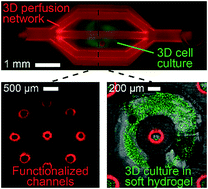Our official English website, www.x-mol.net, welcomes your feedback! (Note: you will need to create a separate account there.)
Stereolithographic hydrogel printing of 3D culture chips with biofunctionalized complex 3D perfusion networks
Lab on a Chip ( IF 6.1 ) Pub Date : 2017-11-03 00:00:00 , DOI: 10.1039/c7lc00926g Rujing Zhang 1, 2, 3, 4, 5 , Niels B. Larsen 1, 2, 3, 4, 5
Lab on a Chip ( IF 6.1 ) Pub Date : 2017-11-03 00:00:00 , DOI: 10.1039/c7lc00926g Rujing Zhang 1, 2, 3, 4, 5 , Niels B. Larsen 1, 2, 3, 4, 5
Affiliation

|
Three-dimensional (3D) in vitro models capturing both the structural and dynamic complexity of the in vivo situation are in great demand as an alternative to animal models. Despite tremendous progress in engineering complex tissue/organ models in the past decade, approaches that support the required freedom in design, detail and chemistry for fabricating truly 3D constructs have remained limited. Here, we report a stereolithographic high-resolution 3D printing technique utilizing poly(ethylene glycol) diacrylate (PEGDA, MW 700) to manufacture diffusion-open and mechanically stable hydrogel constructs as self-contained chips, where confined culture volumes are traversed and surrounded by perfusable vascular-like networks. An optimized resin formulation enables printing of hydrogel chips holding perfusable microchannels with a cross-section as small as 100 μm × 100 μm, and the printed microchannels can be steadily perfused for at least one week. In addition, the integration of multiple independently perfusable and structurally stable channel systems further allows for easy combination of different bulk material volumes at exact relative spatial positions. We demonstrate this structural and material flexibility by embedding a highly compliant cell-laden gelatin hydrogel within the confines of a 3D printed resilient PEGDA hydrogel chip of intermediate compliance. Overall, our proposed strategy represents an automated, cost-effective and high resolution technique to manufacture complex 3D constructs containing microfluidic perfusion networks for advanced in vitro models.
中文翻译:

具有生物功能化的复杂3D灌注网络的3D培养芯片的立体光刻水凝胶印刷
三维(3D)体外模型可捕获体内的结构和动态复杂性除了动物模型以外,对这种情况的需求也很大。尽管在过去的十年中在工程化复杂的组织/器官模型方面取得了巨大的进步,但支持设计真正的3D结构所需的设计,细节和化学方面的自由度的方法仍然受到限制。在这里,我们报告了利用聚(乙二醇)二丙烯酸酯(PEGDA,MW 700)的立体平版印刷高分辨率3D打印技术,以制造扩散开放和机械稳定的水凝胶结构作为自包含芯片,其中受限的培养体积被遍历和包围灌注性血管样网络。经过优化的树脂配方,可以印刷横截面小至100μm×100μm的可灌装微通道的水凝胶芯片,并且可以稳定地灌注至少一个星期的印刷微通道。此外,多个独立可灌装且结构稳定的通道系统的集成还允许在准确的相对空间位置轻松组合不同的散装物料体积。我们通过将高顺应性的载有细胞的明胶水凝胶嵌入中等顺应性的3D打印弹性PEGDA水凝胶芯片的范围内,证明了这种结构和材料的灵活性。总体而言,我们提出的策略代表了一种自动化,具有成本效益的高分辨率技术,可制造包含微流体灌注网络的复杂3D构建体,以实现先进的 我们通过将高顺应性的载有细胞的明胶水凝胶嵌入中等顺应性的3D打印弹性PEGDA水凝胶芯片的范围内,证明了这种结构和材料的灵活性。总体而言,我们提出的策略代表了一种自动化,具有成本效益的高分辨率技术,可制造包含微流体灌注网络的复杂3D构建体,以实现先进的 我们通过将高顺应性的载有细胞的明胶水凝胶嵌入中等顺应性的3D打印弹性PEGDA水凝胶芯片的范围内,证明了这种结构和材料的灵活性。总体而言,我们提出的策略代表了一种自动化,具有成本效益的高分辨率技术,可制造包含微流体灌注网络的复杂3D构建体,以实现先进的体外模型。
更新日期:2017-11-08
中文翻译:

具有生物功能化的复杂3D灌注网络的3D培养芯片的立体光刻水凝胶印刷
三维(3D)体外模型可捕获体内的结构和动态复杂性除了动物模型以外,对这种情况的需求也很大。尽管在过去的十年中在工程化复杂的组织/器官模型方面取得了巨大的进步,但支持设计真正的3D结构所需的设计,细节和化学方面的自由度的方法仍然受到限制。在这里,我们报告了利用聚(乙二醇)二丙烯酸酯(PEGDA,MW 700)的立体平版印刷高分辨率3D打印技术,以制造扩散开放和机械稳定的水凝胶结构作为自包含芯片,其中受限的培养体积被遍历和包围灌注性血管样网络。经过优化的树脂配方,可以印刷横截面小至100μm×100μm的可灌装微通道的水凝胶芯片,并且可以稳定地灌注至少一个星期的印刷微通道。此外,多个独立可灌装且结构稳定的通道系统的集成还允许在准确的相对空间位置轻松组合不同的散装物料体积。我们通过将高顺应性的载有细胞的明胶水凝胶嵌入中等顺应性的3D打印弹性PEGDA水凝胶芯片的范围内,证明了这种结构和材料的灵活性。总体而言,我们提出的策略代表了一种自动化,具有成本效益的高分辨率技术,可制造包含微流体灌注网络的复杂3D构建体,以实现先进的 我们通过将高顺应性的载有细胞的明胶水凝胶嵌入中等顺应性的3D打印弹性PEGDA水凝胶芯片的范围内,证明了这种结构和材料的灵活性。总体而言,我们提出的策略代表了一种自动化,具有成本效益的高分辨率技术,可制造包含微流体灌注网络的复杂3D构建体,以实现先进的 我们通过将高顺应性的载有细胞的明胶水凝胶嵌入中等顺应性的3D打印弹性PEGDA水凝胶芯片的范围内,证明了这种结构和材料的灵活性。总体而言,我们提出的策略代表了一种自动化,具有成本效益的高分辨率技术,可制造包含微流体灌注网络的复杂3D构建体,以实现先进的体外模型。



























 京公网安备 11010802027423号
京公网安备 11010802027423号